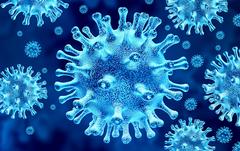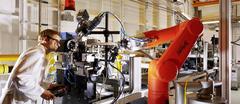URL: https://www.desy.de/news/news_search/index_eng.html
Breadcrumb Navigation
DESY News: Scientists X-ray coronavirus proteins
News
News from the DESY research centre
Scientists X-ray coronavirus proteins
Can the new coronavirus be stopped with drugs? So far, there is no cure for the infection. Research groups around the world are intensively searching for starting points for an active substance against SARS-CoV-2, as the virus was named by the World Health Organization (WHO). A series of experiments now beginning at DESY looks at three key proteins of the pathogen as possible drug targets. If the investigation is successful, it could considerably shorten the search for a drug.

Viruses cannot reproduce on their own. To do this, they hijack cells of their host, introduce their own genetic material into the cells and ‘re-program’ them to produce new viruses, which in turn infect other cells. Proteins play an important role in this cycle. If one of these proteins can be inhibited, this might stop the cycle and the virus can no longer reproduce – the infection is cured.
In their search for such a compound, the scientists at DESY, the Universities of Hamburg and Lübeck and the Fraunhofer Institute for Molecular Biology and Applied Ecology (IME) are following the approach of structural biology: With the bright X-rays from DESY's PETRA III research light source, the three-dimensional spatial structure of proteins can be resolved with an accuracy of 0.1 nanometers. “That is ten millionth of a millimeter. Such a resolution makes it possible to see the individual atoms of the molecule,” says Meents.

The biomolecule beamline P11 at DESY's X-ray light source PETRA III. Credit: DESY, Heiner Müller-Elsner
“The database of the Screening Port contains 3700 active substances that have already been approved for the treatment of humans or are in different stages of testing,” says Meents. “If we should come across a suitable candidate for combating SARS-CoV-2 among them, it could be used in clinical trials much more quickly than in usual drug development. This could save months or even years.”
However, it is not possible to foresee when and if this search will be successful. “Normally such a project is scheduled to last about two years,” Meents reports. “If you do it vigorously, you can speed it up. And if we should have a lucky shot at the beginning, we might come up with a first potential drug candidate after just a few weeks, which can then be tested in cell cultures and later in animal models. Still, our experiments are at the very beginning of drug development and this is usually a long process.”
 Structural analysis of biomolecules with X-ray radiation: Fast electrons (blue) from a particle accelerator are sent into an undulator (left) equipped with powerful magnets (green and violet). The electrons race past the magnets in a slalom pattern. In the process, the particles emit high-energy X-ray radiation (orange), which is directed through X-ray optics at a crystal (centre) made up of biomolecules. The crystal diffracts the X-ray radiation, thus generating a characteristic diffraction pattern on the detector (right). On the basis of this diffraction pattern, the structure of the biomolecules under investigation can be calculated down to the last atom (far right). |



